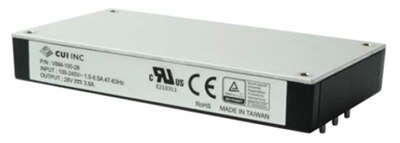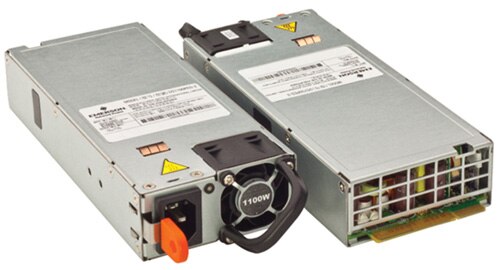Highly-Integrated, Low-Profile AC/DC Converter Modules Are Plug-and-Play Front-End Solutions
投稿人:电子产品
2014-03-11
With the proliferation of distributed power architecture (DPA) and intermediate bus architecture (IBA) in datacenter servers and telecom equipment, system designers are deploying complete AC/DC converters with built-in power-factor correction (PFC) and input/output filtering to meet national and international regulatory energy standards. These converters also are designed to deliver more power from a compact package with an ultra-low profile that meets stringent space requirements and very-high-conversion efficiency to minimize power losses.
Other notable features incorporated in these integrated AC/DC modules include universal input, hot-swap capability, active load sharing for N+1 redundancy, built-in intelligence, and operational flexibility. On-board interfaces such as I²C, PMBus and Ethernet are included to enable real-time monitoring and dynamic digital control based on load levels or other system parameters.
In essence, these integrated and efficient universal input AC/DC front-end modules are being deployed as complete sub-systems to power a variety of DC/DC converters spread across the system. And while this laundry list of required features and benefits might be expected to frighten off some suppliers, there are in fact a number of manufacturers competing in this arena. Among the companies delivering plug-and-play AC front-end solutions for these applications are names like CUI, Artesyn Embedded Technologies (the former Emerson Embedded Computing & Power business of Emerson Network Power), GE Energy, TDK-Lambda, and Vicor Corp.
This article will describe some recently introduced plug-and-play type AC/DC front-ends and highlight key features tailored for applications such as ITE, telecom and datacom systems, and industrial usage.
Plug-and-play AC/DC modules
CUI, for instance, has released a high-efficiency 100 W baseplate-cooled AC/DC front-end with an ultra-low profile (17 mm) in an encapsulated board-mount package (Figure 1). With built-in filtering and protection, along with high power-conversion efficiency, the VBM-100 series is tailored to meet the specific needs of ITE, telecommunications, and industrial applications where space limitations and/or noise restrictions limit the use of fans for cooling. Since DPA architecture has evolved to IBA, wherein the 48 VDC bus is further reduced to 24 or 12 VDC using intermediate DC/DC bus converters, VBM-100 offers a choice of six tightly-regulated output voltages of 12, 15, 24, 28, 36, and 48 VDC with a voltage accuracy of ±1% at 25°C. Custom voltages are also available on request, according to the manufacturer.

Figure 1: CUI’s high-efficiency 100 W baseplate-cooled AC/DC front-end is a plug-and-play solution in an encapsulated board-mount package with an ultra-low profile.
Measuring just 4.5 x 2.4 x 0.6 in. (117 x 61 x 17 mm), the VBM-100 series provides a universal input range of 90~264 VAC and incorporates active power-factor correction (PFC) to meet the EN61000-3-2 Class D harmonic noise standard. The encapsulated units offer a no-load power consumption of less than 0.5 W and run at efficiencies of up to 92 percent. According to CUI, the VBM-100 AC/DC front-end supply operates at temperatures between –20° and +85°C and offers protection against overvoltage, short-circuit, and overtemperature. As a result, all models carry UL/cUL and TUV 60950-1 safety certifications for ITE, commercial, and industrial equipment, and are compliant with the EMC directive EN 55022 Class B without the need for external filtering.
Similarly, for systems that use DPA and IBA architectures, Artesyn Embedded Technologies has readied 1U-, 2U-, and 3U-high rack-mounted AC/DC front-ends with individual power ratings up to 3,000 W. Recently, the company has expanded its DS series of 1U high ultra-compact AC/DC front-ends with two models for space-constrained, high-availability applications such as “always-on” enterprise servers. These include the 750 W unit DS750PED and 1,100 W model DS1100PED. Designed to meet the 80Plus Platinum standard for efficiency (Table 1), the power supplies share the same form-factor (Figure 2), providing the scalability that system designers need for long lifecycle applications where power requirements may change in the future. Both power supplies offer a peak conversion efficiency of 94 percent with a high power density; the DS750PED provides density up to 16.4 W/in.³ (1 W/cm³) and DS1100PED delivers 24 W/in.³ (1.46 W/cm³).

Table 1: Computed efficiency for DS1100PED shows that the AC/DC front-end meets the 80Plus Platinum standard for efficiency.

Figure 2: Artesyn Embedded Technologies’ (previously called Emerson Network Power) new DS series AC/DC front-ends share the same form-factor to provide the scalability that system designers need in applications where power requirements may change in the future.
Handling a universal input voltage range, the power supplies use active PFC to maximize efficiency and ensure compliance with the international EN 61000-3-2 standard for harmonic current emission. In fact, the supplier claims that DS750PED and DS1100PED offer a power factor of at least 0.9 for load conditions from 20 percent to full output. This ensures that when these power supplies are paralleled for fault tolerance or redundancy they still operate at high efficiency even when only partially loaded.
What is more, these latest additions to an expanding range of power supplies feature PMBus-compliant control and monitoring functions. Each power supply generates a main payload output of 12 VDC for feeding downstream DC/DC converters in systems using distributed architectures, along with a 12 VDC standby output rated at 3 A for power-management circuitry. The main DC output of the DS750PED and DS1100PED can deliver up to 62.5 and 91.6 A, respectively, and stays within regulation down to zero load. Active current sharing helps maximize cost-effectiveness by eliminating the need for additional components when paralleling multiple power supplies for very-high-current applications.
The AC/DC front-ends also feature built-in ORing and limited inrush current with a 38 A limit on the model DS750PED and 55 A on the DS1100PED. In addition, the units comply with the EN 61000-4-11 standard for EMC immunity and offer a wide set of safety approvals, including UL/cUL/EN 60950, CE Mark, and China CCC.
Additional solutions
Not to be left behind, GE’s Critical Power business, formerly Lineage Power, offers its efficient CAR series as plug-and-play AC/DC front-ends from worldwide input mains in a compact 1U industry standard form-factor. The CAR series boasts an unprecedented power density of 25 W/in3. Offering single outputs of 12, 24, and 48 VDC, the CAR AC/DC front-ends are hot-swappable with built-in remote On/Off, remote sense, active current sharing, output voltage margining, overvoltage, overcurrent, and overtemperature protection. The line also features an I²C/PMBus interface that provides a full range of control and monitoring capabilities. With respect to efficiency, the GE modules surpass the 80Plus Gold Level efficiency standard.
While the 2500 W CAR2548 is tailored for systems with a 48 VDC bus, the 2,000 W CAR2024FP is designed for a 24 VDC bus. The series also offers 12 VDC output with output power ranging from 850 W (CAR0812FP) to 2,500 W (CAR2512FP).
For distributed power, hot-pluggable, and redundant power systems, TDK-Lambda has prepared its 2,500 W HFE2500 series with universal AC input capability and built-in active PFC. The series provides a well-regulated DC output of 12, 24, or 48 V. Offering 80Plus Platinum level performance, the units in the HFE2500 series are fully RoHS compliant, carry the CE mark and meet UL/EN60950-1 safety specifications, as well as EN55022 and FCC Class B EMC conducted specifications.
To address this market, Vicor has combined its proprietary double-clamp zero-voltage switching (DC-ZVS) architecture with patented adaptive-cell topology to deliver a complete AC/DC front-end with an unprecedented combination of power density, conversion efficiency and flexibility, while also meeting harmonic noise, EMI, and safety-extra-low-voltage (SELV) output requirements. Handling worldwide AC mains input, the 330 W VI Brick (FE175D480C033FP-00) module offers a fully-isolated and regulated 48 VDC output from a low-profile package measuring only 0.38 in. (9.55 mm) in height. It is compatible with a wide variety of downstream DC/DC converters supplied by Vicor. As a result, it can be easily combined (Figure 3) with the company’s high-density, high-efficiency DC/DC converters, including PRM and VTM regulators, to create a universal AC to 12 VDC bus and 1 V point-of-load (POL) solution. The VI Brick AC/DC front-end is offered in three temperature grades: consumer, telecom, and military.

Figure 3: The VI Brick AC/DC front-end can be combined with Vicor’s downstream DC/DC converters, including PRM and VTM regulators, to create a universal AC to 12 VDC bus and 1 V point-of-load (POL) solution.
In summary, plug-and-play AC/DC front-end sub-systems continue to evolve as more bells and whistles are added to make the life of a systems designer easier. These converters eliminate the worry of designing the AC/DC front-end module, giving the system designer more time to focus on other key issues pertaining to the end product.
For more information on the products discussed in this article, use the links provided to access product pages on the Digi-Key website.
免责声明:各个作者和/或论坛参与者在本网站发表的观点、看法和意见不代表 DigiKey 的观点、看法和意见,也不代表 DigiKey 官方政策。





